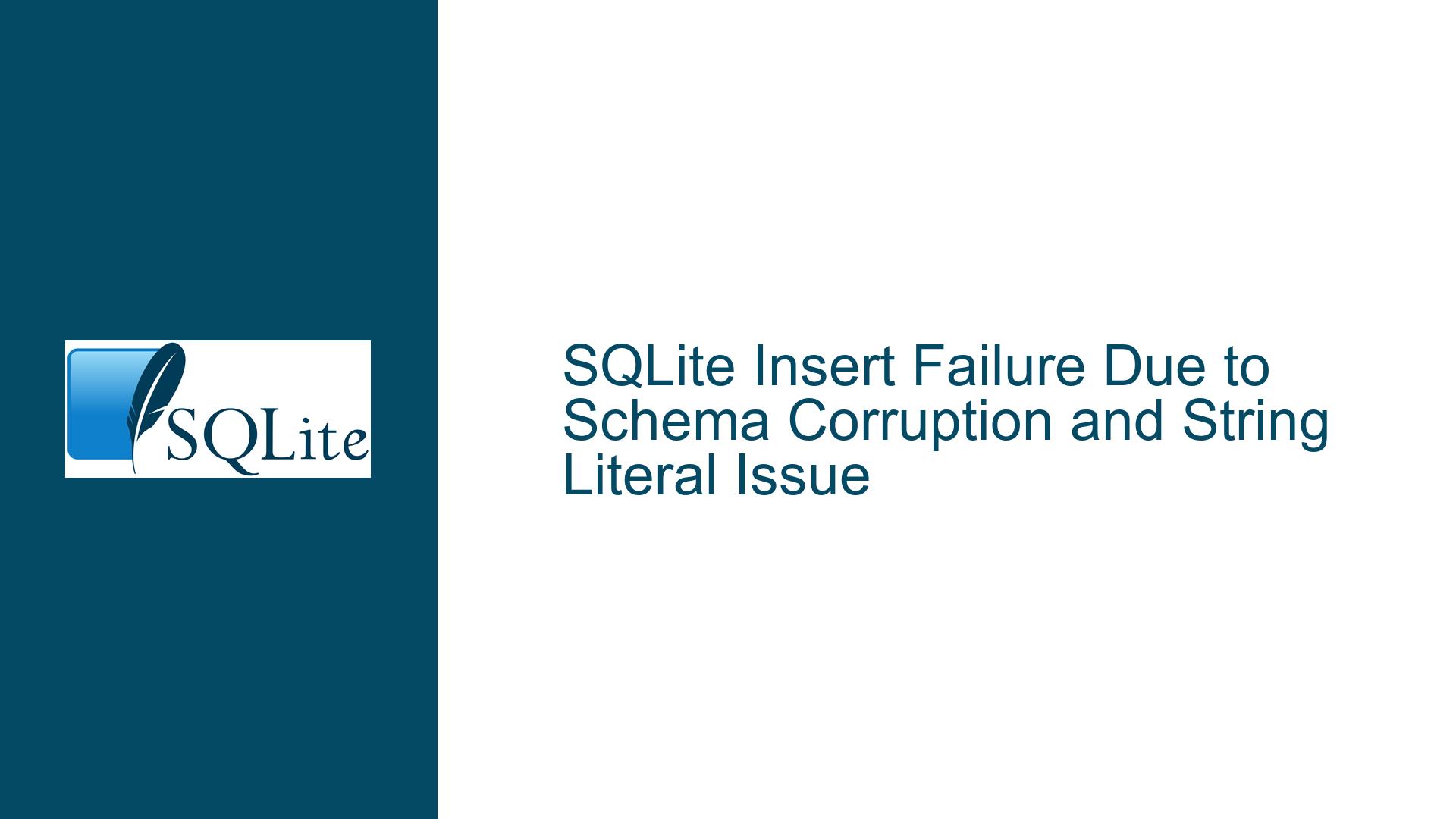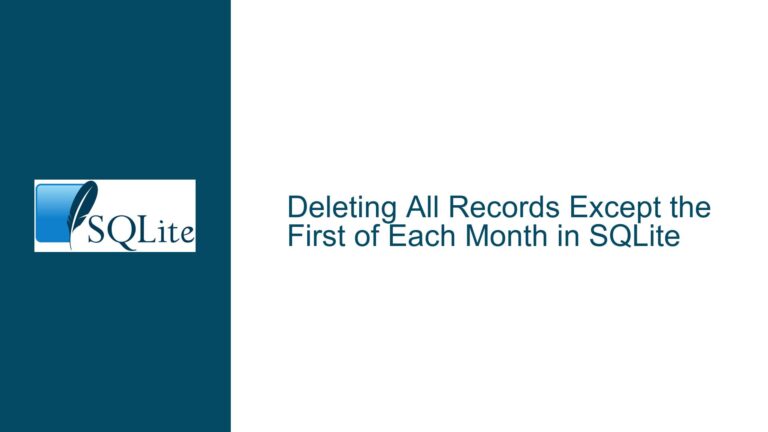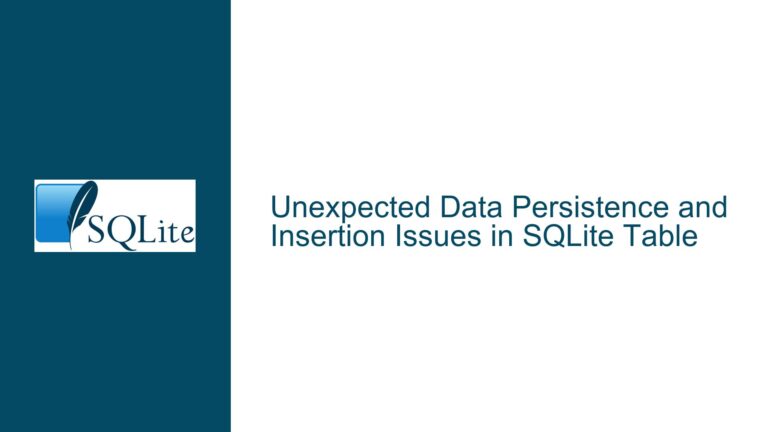SQLite Insert Failure Due to Schema Corruption and String Literal Issue
SQLite Database Corruption After Schema Initialization
When attempting to insert a record into a SQLite table, the operation fails with a SQLITE_CORRUPT error. This error typically indicates that the database schema has become corrupted, often due to interrupted write operations, improper schema initialization, or issues with the database file itself. In this case, the error arises during the schema initialization process, specifically when the sqlite3InitCallback function is invoked. The callback function returns SQLITE_CORRUPT, which suggests that the schema metadata is either missing or invalid.
The schema initialization process in SQLite involves reading the sqlite_master table, which contains the database schema definitions. If this table is corrupted or if the schema metadata is inconsistent, SQLite will flag the database as corrupt. The error message indicates that the corruption was detected when the corruptSchema function was called, which is triggered when the schema metadata is found to be invalid. This can happen if the schema was not properly initialized or if there was an interruption during the schema creation process.
The issue is further compounded by the fact that the INSERT statement in question contains a string literal that is not properly quoted. In SQLite, string literals must be enclosed in single quotes. The absence of single quotes around the string "Jerry" in the INSERT statement causes SQLite to interpret it as an identifier rather than a string. This can lead to unexpected behavior, especially if the identifier does not correspond to any existing table or column name.
Interrupted Write Operations Leading to Schema Corruption
The root cause of the SQLITE_CORRUPT error can be traced back to several potential issues, the most likely being interrupted write operations during schema initialization. SQLite uses a write-ahead log (WAL) or rollback journal to ensure data integrity, but if a write operation is interrupted—such as by a power failure or an abrupt termination of the application—the schema metadata can become inconsistent. This inconsistency can manifest as a corrupted schema, which SQLite detects during the initialization process.
Another possible cause is the improper handling of the sqlite_master table. This table is crucial for SQLite’s operation, as it stores the schema definitions for all tables, indexes, triggers, and views in the database. If this table is corrupted or if its contents are altered in an unexpected way, SQLite will be unable to properly initialize the schema, leading to a SQLITE_CORRUPT error. This can happen if the table is manually modified or if there is a bug in the application code that interacts with the database.
The issue with the unquoted string literal in the INSERT statement further exacerbates the problem. When SQLite encounters an unquoted string, it attempts to interpret it as an identifier. If the identifier does not match any existing table or column name, SQLite will throw an error. In this case, the absence of single quotes around "Jerry" causes SQLite to interpret it as an identifier, which likely does not correspond to any valid column or table name in the database. This can lead to a cascade of errors, especially if the application code does not properly handle such exceptions.
Implementing PRAGMA journal_mode and Proper String Literal Handling
To resolve the SQLITE_CORRUPT error and prevent future occurrences, it is essential to address both the schema corruption issue and the improper handling of string literals. The following steps outline the troubleshooting process and the necessary fixes:
Step 1: Verify and Repair the Database Schema
The first step is to verify the integrity of the database schema. SQLite provides the PRAGMA integrity_check command, which checks the database for corruption. Running this command will identify any inconsistencies in the schema or data. If corruption is detected, the database should be repaired using the PRAGMA quick_check command, which performs a less thorough but faster check. If the corruption is severe, it may be necessary to restore the database from a backup.
PRAGMA integrity_check;
PRAGMA quick_check;
If the schema is found to be corrupted, the next step is to rebuild the database. This can be done by exporting the data to a SQL script using the .dump command in the SQLite command-line interface, creating a new database, and then importing the data from the script. This process ensures that the schema is recreated correctly and that any inconsistencies are resolved.
sqlite3 corrupted.db ".dump" > backup.sql
sqlite3 new.db < backup.sql
Step 2: Implement PRAGMA journal_mode for Data Integrity
To prevent future schema corruption, it is recommended to enable the Write-Ahead Logging (WAL) mode in SQLite. WAL mode provides better concurrency and reduces the risk of corruption due to interrupted write operations. The WAL mode can be enabled using the PRAGMA journal_mode command:
PRAGMA journal_mode=WAL;
WAL mode works by writing changes to a separate WAL file before applying them to the main database file. This allows multiple readers and writers to access the database simultaneously without blocking each other. In the event of a crash or power failure, SQLite can recover the database by replaying the changes from the WAL file, ensuring data integrity.
Step 3: Properly Handle String Literals in SQL Statements
The issue with the unquoted string literal in the INSERT statement can be resolved by ensuring that all string literals are properly enclosed in single quotes. In SQLite, string literals must be enclosed in single quotes to be interpreted correctly. The corrected INSERT statement should look like this:
INSERT INTO student(name, score) VALUES ('Jerry', 90);
This ensures that SQLite interprets "Jerry" as a string literal rather than an identifier. It is also good practice to use parameterized queries to avoid SQL injection and other issues related to string handling. Parameterized queries separate the SQL code from the data, making it easier to handle special characters and preventing syntax errors.
import sqlite3
conn = sqlite3.connect('example.db')
cursor = conn.cursor()
cursor.execute("INSERT INTO student(name, score) VALUES (?, ?)", ('Jerry', 90))
conn.commit()
Step 4: Monitor and Log Database Operations
To further enhance the reliability of the database, it is recommended to implement logging and monitoring of database operations. This can help identify and diagnose issues before they lead to corruption. SQLite provides several PRAGMA commands that can be used to enable logging and monitoring, such as PRAGMA foreign_key_check and PRAGMA synchronous.
PRAGMA foreign_key_check;
PRAGMA synchronous=FULL;
The PRAGMA synchronous command controls how aggressively SQLite writes data to disk. Setting it to FULL ensures that all data is written to disk before the transaction is considered complete, reducing the risk of corruption in the event of a crash.
Step 5: Regular Database Backups
Finally, regular database backups are essential to ensure data integrity and recoverability. SQLite provides several methods for backing up databases, including the .backup command in the SQLite command-line interface and the sqlite3_backup_init API for programmatic backups. Regular backups should be scheduled to minimize data loss in the event of corruption or other issues.
sqlite3 example.db ".backup backup.db"
By following these steps, the SQLITE_CORRUPT error can be resolved, and future occurrences can be prevented. Proper schema management, data integrity measures, and careful handling of SQL statements are key to maintaining a healthy SQLite database.






